Protective Action of Anandamide and Its COX-2 Metabolite against l-Homocysteine-Induced NLRP3 Inflammasome Activation and Injury in Podocytes
- PMID: 27189966
- PMCID: PMC4931881
- DOI: 10.1124/jpet.116.233239
Protective Action of Anandamide and Its COX-2 Metabolite against l-Homocysteine-Induced NLRP3 Inflammasome Activation and Injury in Podocytes
Abstract
Recent studies have demonstrated that l-homocysteine (Hcys)-induced podocyte injury leading to glomerular damage or sclerosis is attributable to the activation of the nucleotide-binding oligomerization domain-like receptor containing pyrin domain 3 (NLRP3) inflammasome. Given the demonstrated anti-inflammatory effects of endocannabinoids, the present study was designed to test whether anandamide (AEA) or its metabolites diminish NLRP3 inflammasome activation and prevent podocyte injury and associated glomerular damage during hyperhomocysteinemia (hHcys). AEA (100 μM) inhibited Hcys-induced NLRP3 inflammasome activation in cultured podocytes, as indicated by elevated caspase-1 activity and interleukin-1β levels, and attenuated podocyte dysfunction, as shown by reduced vascular endothelial growth factor production. These effects of AEA were inhibited by the cyclooxygenase-2 (COX-2) inhibitor celecoxib (CEL). In mice in vivo, AEA treatment attenuated glomerular NLRP3 inflammasome activation induced by hHcys accompanying a folate-free diet, on the basis of inhibition of hHcys-induced colocalization of NLRP3 molecules and increased interleukin-1β levels in glomeruli. Correspondingly, AEA prevented hHcys-induced proteinuria, albuminuria, and glomerular damage observed microscopically. Hcys- and AEA-induced effects were absent in NLRP3-knockout mice. These beneficial effects of AEA against hHcys-induced NLRP3 inflammasome activation and glomerular injury were not observed in mice cotreated with CEL. We further demonstrated that prostaglandin E2-ethanolamide (PGE2-EA), a COX-2 product of AEA, at 10 μM had a similar inhibitory effect to that of 100 μM AEA on Hcys-induced NLRP3 inflammasome formation and activation in cultured podocytes. From these results, we conclude that AEA has anti-inflammatory properties, protecting podocytes from Hcys-induced injury by inhibition of NLRP3 inflammasome activation through its COX-2 metabolite, PGE2-EA.
Copyright © 2016 by The American Society for Pharmacology and Experimental Therapeutics.
Figures
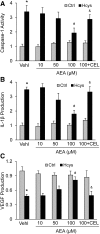
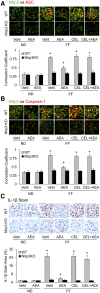
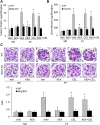
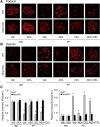

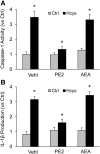
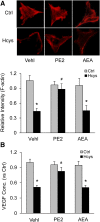

Similar articles
-
NLRP3 inflammasome as a novel target for docosahexaenoic acid metabolites to abrogate glomerular injury.J Lipid Res. 2017 Jun;58(6):1080-1090. doi: 10.1194/jlr.M072587. Epub 2017 Apr 12. J Lipid Res. 2017. PMID: 28404641 Free PMC article.
-
Contribution of guanine nucleotide exchange factor Vav2 to NLRP3 inflammasome activation in mouse podocytes during hyperhomocysteinemia.Free Radic Biol Med. 2017 May;106:236-244. doi: 10.1016/j.freeradbiomed.2017.02.027. Epub 2017 Feb 11. Free Radic Biol Med. 2017. PMID: 28193546 Free PMC article.
-
Nod-like receptor protein 3 (NLRP3) inflammasome activation and podocyte injury via thioredoxin-interacting protein (TXNIP) during hyperhomocysteinemia.J Biol Chem. 2014 Sep 26;289(39):27159-27168. doi: 10.1074/jbc.M114.567537. Epub 2014 Aug 19. J Biol Chem. 2014. PMID: 25138219 Free PMC article.
-
Contribution of endogenously produced reactive oxygen species to the activation of podocyte NLRP3 inflammasomes in hyperhomocysteinemia.Free Radic Biol Med. 2014 Feb;67:211-20. doi: 10.1016/j.freeradbiomed.2013.10.009. Epub 2013 Oct 16. Free Radic Biol Med. 2014. PMID: 24140862 Free PMC article.
-
Not an immune cell, but they may act like one-cells with immune properties outside the immune system.Immunol Cell Biol. 2024 Jul;102(6):487-499. doi: 10.1111/imcb.12752. Epub 2024 Apr 22. Immunol Cell Biol. 2024. PMID: 38650437 Review.
Cited by
-
FAAH served a key membrane-anchoring and stabilizing role for NLRP3 protein independently of the endocannabinoid system.Cell Death Differ. 2023 Jan;30(1):168-183. doi: 10.1038/s41418-022-01054-4. Epub 2022 Sep 14. Cell Death Differ. 2023. PMID: 36104448 Free PMC article.
-
Modulatory Potential of Cannabidiol on the Opioid-Induced Inflammatory Response.Cannabis Cannabinoid Res. 2021 Jun;6(3):211-220. doi: 10.1089/can.2020.0181. Cannabis Cannabinoid Res. 2021. PMID: 34115948 Free PMC article. Review.
-
Anandamide Influences Interleukin-1β Synthesis and IL-1 System Gene Expressions in the Ovine Hypothalamus during Endo-Toxin-Induced Inflammation.Animals (Basel). 2021 Feb 12;11(2):484. doi: 10.3390/ani11020484. Animals (Basel). 2021. PMID: 33673103 Free PMC article.
-
Podocytopathy and Nephrotic Syndrome in Mice with Podocyte-Specific Deletion of the Asah1 Gene: Role of Ceramide Accumulation in Glomeruli.Am J Pathol. 2020 Jun;190(6):1211-1223. doi: 10.1016/j.ajpath.2020.02.008. Epub 2020 Mar 16. Am J Pathol. 2020. PMID: 32194052 Free PMC article.
-
NLRP3 inflammasome as a novel target for docosahexaenoic acid metabolites to abrogate glomerular injury.J Lipid Res. 2017 Jun;58(6):1080-1090. doi: 10.1194/jlr.M072587. Epub 2017 Apr 12. J Lipid Res. 2017. PMID: 28404641 Free PMC article.
References
Publication types
MeSH terms
Substances
Grants and funding
LinkOut - more resources
Full Text Sources
Other Literature Sources
Research Materials

